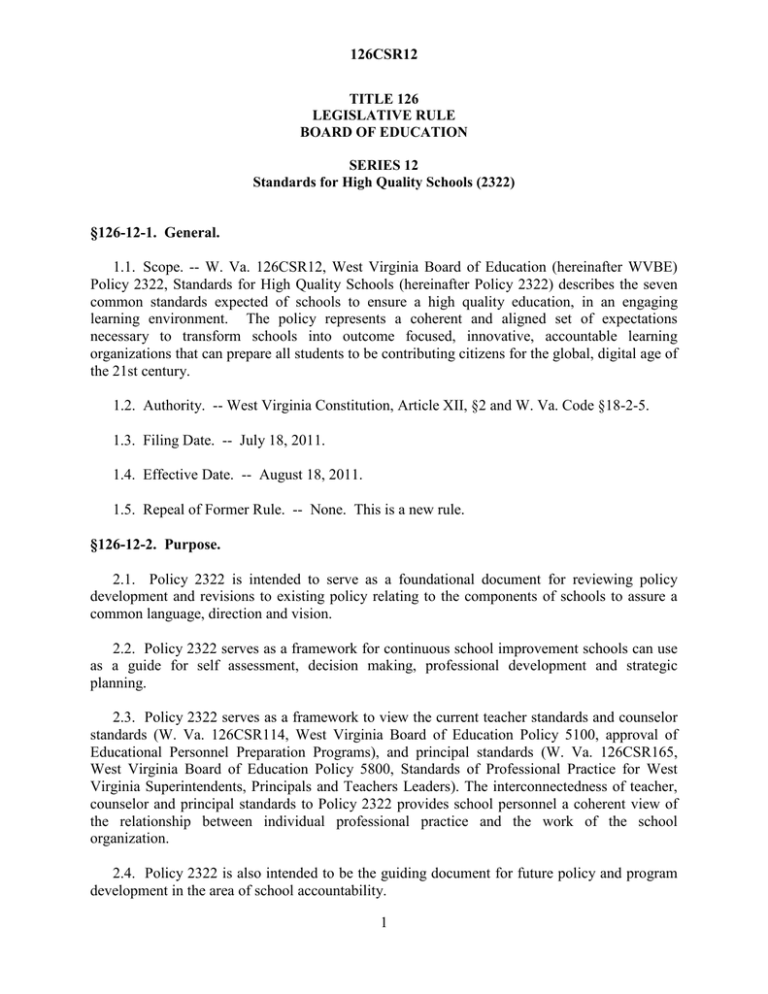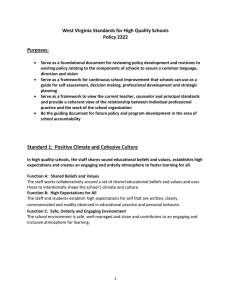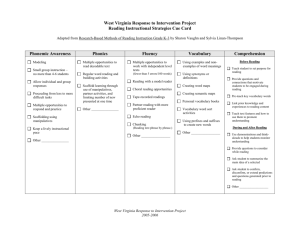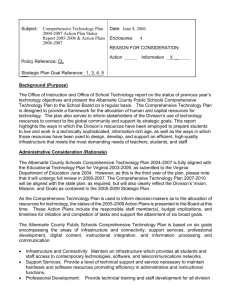126CSR12 §126-12-1. General.
advertisement

126CSR12 TITLE 126 LEGISLATIVE RULE BOARD OF EDUCATION SERIES 12 Standards for High Quality Schools (2322) §126-12-1. General. 1.1. Scope. -- W. Va. 126CSR12, West Virginia Board of Education (hereinafter WVBE) Policy 2322, Standards for High Quality Schools (hereinafter Policy 2322) describes the seven common standards expected of schools to ensure a high quality education, in an engaging learning environment. The policy represents a coherent and aligned set of expectations necessary to transform schools into outcome focused, innovative, accountable learning organizations that can prepare all students to be contributing citizens for the global, digital age of the 21st century. 1.2. Authority. -- West Virginia Constitution, Article XII, §2 and W. Va. Code §18-2-5. 1.3. Filing Date. -- July 18, 2011. 1.4. Effective Date. -- August 18, 2011. 1.5. Repeal of Former Rule. -- None. This is a new rule. §126-12-2. Purpose. 2.1. Policy 2322 is intended to serve as a foundational document for reviewing policy development and revisions to existing policy relating to the components of schools to assure a common language, direction and vision. 2.2. Policy 2322 serves as a framework for continuous school improvement schools can use as a guide for self assessment, decision making, professional development and strategic planning. 2.3. Policy 2322 serves as a framework to view the current teacher standards and counselor standards (W. Va. 126CSR114, West Virginia Board of Education Policy 5100, approval of Educational Personnel Preparation Programs), and principal standards (W. Va. 126CSR165, West Virginia Board of Education Policy 5800, Standards of Professional Practice for West Virginia Superintendents, Principals and Teachers Leaders). The interconnectedness of teacher, counselor and principal standards to Policy 2322 provides school personnel a coherent view of the relationship between individual professional practice and the work of the school organization. 2.4. Policy 2322 is also intended to be the guiding document for future policy and program development in the area of school accountability. 1 126CSR12 §126-12-3. Standards for High Quality Schools. 3.1. Standards. 3.2.1. Positive Climate and Cohesive Culture. In high quality schools, the staff shares sound educational beliefs and values, establishes high expectations and creates an engaging and orderly atmosphere to foster learning for all. 3.2.1.a. Shared Beliefs and Values. The staff works collaboratively around a set of shared educational beliefs and values and uses these to intentionally shape the school’s climate and culture. 3.2.1.b. High Expectations for All. The staff and students establish high expectations for self that are written, clearly communicated and readily observed in educational practice and personal behavior. 3.2.1.c. Safe, Orderly and Engaging Environment. The school environment is safe, well-managed and clean and contributes to an engaging and inclusive atmosphere for learning. 3.2.2. School Leadership. In high quality schools, the principal fosters and develops distributed leadership among staff, students, and stakeholders in order to focus collective action for improved school performance. 3.2.2.a. Principal Leadership. The principal exhibits the professional knowledge, skills and dispositions that reflect strong leadership and effective management. 3.2.2.b. School Teams and Councils. The school teams and councils function effectively to advance the mission and goals of the school through leadership, planning, shared decision making and problem-solving. 3.2.2.c. Teacher Leadership. Teachers assume responsibility for school and classroom improvement and are provided authentic opportunities and resources to lead and influence professional practice. 3.2.2.d. Student Leadership. Students are engaged in age-appropriate leadership opportunities that develop self-direction and a sense of responsibility for improving self, school and community. 3.2.3. Standards-Focused Curriculum, Instruction and Assessments. In high quality schools, the staff delivers a standards-focused curriculum that enhances the unique qualities of each learner and assures that all students attain the essential knowledge, skills and dispositions necessary in the global, digital age. 2 126CSR12 3.2.3.a. Classroom Learning Environment. Teachers create and manage an inviting classroom environment that is student-centered and fosters student reflection, intellectual inquiry and self-direction. 3.2.3.b. Standards-Focused Curriculum. Teachers implement a standards-focused curriculum aligned with the 21st Century Content Standards and Objectives for West Virginia Schools and the 21st Century Learning Skills and Technology Tools. 3.2.3.c. Instructional Planning. Teachers design long and short term instructional plans for guiding student mastery of the Content Standards and Objectives based on the needs, interests and performance levels of their students. 3.2.3.d. Instructional Delivery. Teachers facilitate engaging instructional experiences that enhance individual student progress in mastery of the curriculum using multiple strategies, appropriate assessments, learning resources, digital tools and processes aligned with instructional targets. 3.2.4. Student Support Services and Family/Community Connections. In high quality schools, the staff places student well-being at the forefront of all decisions, provides support services to address student physical, social/emotional and academic growth, and forms positive connections to families and the community. 3.2.4.a. Positive Relationships. Positive relationships exist between the school staff and the students, families and the larger community. 3.2.4.b. Student Personal Development. The school staff attends to student physical, social-emotional and academic well-being through coordinated student support services for health, child nutrition, character education, guidance and counseling, special education and English second language. 3.2.4.c. Parent and Community Partnerships. The school staff forms partnerships with various community agencies and organizations to enhance the ability to meet the needs of all students. 3.2.5. Educator Growth and Development. In high quality schools, staff members participate in processes of self reflection, collaboration and evaluation that lead to professional growth and development in order to impact student learning. 3.2.5.a. Professional Development. The staff engages in continuous learning opportunities for professional growth designed to improve school and classroom practice. 3.2.5.b. Teacher Collaboration. The teachers participate in high functioning collaborative teams to improve student learning through the study of relevant data, problem analysis and the implementation of strategies that improve instructional practice. 3 126CSR12 3.2.5.c. Evaluation, Feedback and Support. The staff participates in processes of evaluation that facilitate self-reflection and informs the process of professional growth. 3.2.6. Efficient and Effective Management. In high quality schools, efficient and effective management procedures assure that facilities, fiscal resources, personnel, and data and technology systems add value to student learning and comply with law and policy. 3.2.6.a. Facilities. Facilities are safe and secure, clean, well maintained, aesthetically pleasing, and configured to meet the learning needs of students. 3.2.6.b. Fiscal Resources. Policies and processes are established and applied to obtain, allocate and efficiently manage school fiscal resources. 3.2.6.c. Personnel. High quality personnel are selected according to West Virginia Code and are purposefully assigned and retained to effectively meet the identified needs of students. 3.2.6.d. Data, Information Systems, Technology Tools and Infrastructure. The school has appropriate technology infrastructure and utilizes data information systems and technology tools to support management, instructional delivery and student learning. 3.2.7. Continuous Improvement. In high quality schools, there is collective commitment to collaboratively identify, plan, implement, monitor, evaluate, and communicate the changes necessary to continuously increase student learning. 3.2.7.a. Focused and Coherent Plan. The staff establishes a coherent approach for improving the performance of students based on the mission and goals outlined in the strategic plan. 3.2.7.b. Processes and Structures. The staff has well-defined structures for building professional relationships and processes necessary to collaboratively engage all stakeholders in actions to increase student learning. 3.2.7.c. Monitoring for Results. The staff monitors changes in practice and implements adjustments, evaluates the results of student learning, and communicates the progress to all stakeholders. §126-12-4. Severability. 4.1. If any provision of this rule or the application thereof to any person or circumstance is held invalid, such invalidity shall not affect other provisions or applications of this rule. 4




